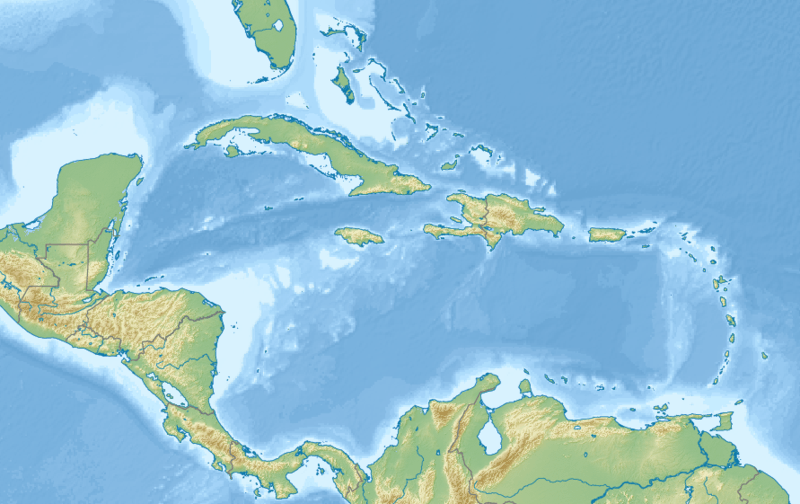Asomante, Aguada, Puerto Rico
Asomante is a barrio in the municipality of Aguada, Puerto Rico. Its population in 2010 was 3,177.[3][4][5]
Asomante | |
|---|---|
Barrio | |
 Location of Asomante within the municipality of Aguada shown in red | |
 Asomante Location of Puerto Rico | |
| Coordinates: 18°23′02″N 67°10′20″W[1] | |
| Commonwealth | |
| Municipality | |
| Area | |
| • Total | 1.834 sq mi (4.75 km2) |
| • Land | 1.834 sq mi (4.75 km2) |
| • Water | 0 sq mi (0 km2) |
| Elevation | 52 ft (16 m) |
| Population (2010) | |
| • Total | 3,177 |
| • Density | 1,736.1/sq mi (670.3/km2) |
| Source: 2010 Census | |
| Time zone | UTC−4 (AST) |
History
The United States took control of Puerto Rico from Spain in the aftermath of the Spanish-American War under the terms of the Treaty of Paris of 1898. In 1899, the United States conducted its first census of Puerto Rico finding that the combined population of Asomante barrio and Piedras Blancas barrio was 1,162.[6]
Sectors
Barrios (which are like minor civil divisions)[7] in turn are further subdivided into smaller local populated place areas/units called sectores (sectors in English). The types of sectores may vary, from normally sector to urbanización to reparto to barriada to residencial, among others.
The following sectors are in Asomante barrio:[8]
Apartamentos Portales del Navegante, Avenida Rotario, Carretera 416 (west side), Carretera 417 Norte, Carretera 417 Sur, Égida Hogar Mi Casita Feliz, Hogar María del Carmen, Parcelas Las Minas, Reparto Bonet, Residencial Aguada Gardens, Residencial Los Almendros, Sector Acevedo, Sector Brisas de Coloso, Sector Colinas del Valle, Sector Corozas, Sector Cuesta Los Chicharrones, Sector Las Guabas, Sector Los Quiñones, Sector Muñiz, Sector Vargas, Sector Vertedero, Sector Villa Alameda, Sector Villarrubia, Urbanización Los Flamboyanes, Urbanización San Francisco, Urbanización y Extensión Jardines de Aguada, and Urbanización y Extensión San José.
In Asomante barrio is part of the Aguada urban zone.[5]
Earthquakes
During the 2019-2020 Puerto Rico earthquakes the Lydia Meléndez School in Asomante served as a refuge for residents from Cerro Gordo, Las Marías and Atalaya (nearby barrios) who had to leave their damaged homes.[9]
References
- "US Gazetteer". US Census. US Government.
- U.S. Geological Survey Geographic Names Information System: Asomante Barrio
- Picó, Rafael; Buitrago de Santiago, Zayda; Berrios, Hector H. Nueva geografía de Puerto Rico: física, económica, y social, por Rafael Picó. Con la colaboración de Zayda Buitrago de Santiago y Héctor H. Berrios. San Juan Editorial Universitaria, Universidad de Puerto Rico,1969.
- Gwillim Law (20 May 2015). Administrative Subdivisions of Countries: A Comprehensive World Reference, 1900 through 1998. McFarland. p. 300. ISBN 978-1-4766-0447-3. Retrieved 25 December 2018.
- Puerto Rico:2010:population and housing unit counts.pdf (PDF). U.S. Dept. of Commerce, Economics and Statistics Administration, U.S. Census Bureau. 2010.
- Joseph Prentiss Sanger; Henry Gannett; Walter Francis Willcox (1900). Informe sobre el censo de Puerto Rico, 1899, United States. War Dept. Porto Rico Census Office (in Spanish). Imprenta del gobierno. p. 160.
- "US Census Barrio-Pueblo definition". factfinder.com. US Census. Archived from the original on 13 May 2017. Retrieved 5 January 2019.
- "DESGLOSE DE SECTORES Y CENTROS DE VOTACIÓN PRECINTO ELECTORAL - AGUADA 038" (PDF). Comisión Estatal de Elecciones Puerto Rico (in Spanish). 28 October 2019. Retrieved 16 June 2020.
- "Estos son los daños e incidentes reportados en cada pueblo tras el poderoso terremoto de 6.4 [These are the damages and incidents reported in each town after the strong 6.4 earthquake]". El Nuevo Dia (in Spanish). 7 January 2020. Retrieved 23 June 2020.